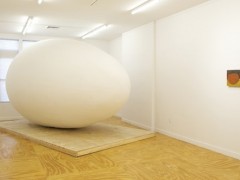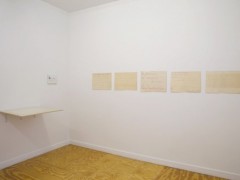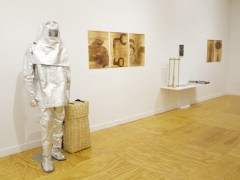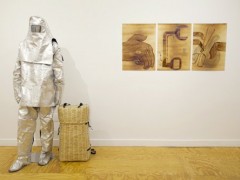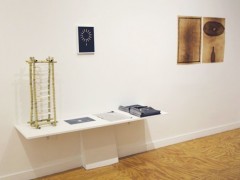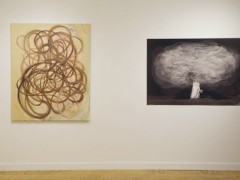We, The Outsider
05.09– 01.11 / 2014
e-flux, New York
“When I use a word,” Humpty Dumpty said, in rather a scornful tone, “it means just what I choose it to mean—neither more nor less.” “The question is,” said Alice, “whether you can make words mean so many different things.” “The question is,” said Humpty Dumpty, “which is to be master—that’s all.”
—Lewis Carroll (Charles L. Dodgson), Through the Looking-Glass (1934), 205. First published in 1872.
Can it be said that art has a consciousness of its own? And if such a consciousness were independent of us, where would it place us in relation to itself?
We, The Outsiders revolves around a single work—a gigantic egg—by Argentinian artist Federico Manuel Peralta Ramos that provides a title and script for an exhibition that investigates where consciousness begins and ends in relation to art. Titled Nosotros afuera [We, the Outsiders] (1965), the egg is a microcosm of the space of creation that we cannot immediately access, and it silently remaps and inverts our understanding of what is inside and what is outside of consciousness and creation. This gigantic egg marks more of a beginning than an end, but also a moment when the artist declared himself tired of language. He and he alone can decide on the meaning of words. Yet if he remains the only one who knows the meaning, the whole process may end up a radically solipsistic effort.
Peralta Ramos’s egg shares the room with German filmmaker Lutz Mommatz’s film, Markeneier (1967); Argentinean artist Eduardo Navarro’s travelogue to the core of a volcano, and works by Polish painter Agnieszka Brzeżańska. Very little documentation remains of the piece Peralta Ramos created as his contribution to the final Instituto Torcuato di Tella show in 1965. The few black-and-white photographs that exist show the large egg alone with its maker on a thin plinth on the gallery floor. There are some dark areas in the plaster; the piece was not entirely dry at the time of the show. Surviving friends who saw the piece recall that the work was made in such a hurry that it broke immediately after the jury declared it the winner of that year’s Di Tella Art Prize. A relative of Peralta Ramos similarly remembers that the artist miscalculated the tension between the metal structure and the plaster skin, and the piece imploded immediately after the award ceremony. Yet there is also a picture that shows Peralta Ramos destroying the piece himself. Either way, the work was too large to be moved as it was made inside the gallery space, and was always fated for destruction.
The egg stood in front of us—all of us, people from the past as well as the future—and renamed and reinvented the world anew. Peralta Ramos changed the rules and altered the universe that day in Buenos Aires, which might explain why he abandoned painting and sculpture shortly after, instead staging many social gatherings and writing maxims on café napkins over long afternoons in Buenos Aires. He did not stop making art; rather, he started making it from the other side.
Curated by Chus Martínez
Agnieszka Brzeżańska was born in 1972 in Gdansk. She lives and works in Warsaw and Berlin. Recent solo exhibitions include Nomas Foundation, Rome, 2012; Kunsthaus Baselland and DAAD Galerie, Berlin in 2010. Her monograph, L’artiste, Le Modèle et La Peinture, was published in 2010 by Sternberg Press.
Lutz Mommartz is a pioneer of the film genre known as “other cinema.” From 1978 to 1999, he was a professor of film at the Kunstakademie Münster. He lives and works in Germany, dividing his time between Düsseldorf and Berlin.
Eduardo Navarro lives and works in Argentina, where he studied from 2003–2005 with artist Guillermo Kuitca in the Program for the Visual Arts C.C.R.R.. Navarro has had solo exhibitions in Buenos Aires and London and has taken part in numerous group shows in South America, Europe, and New York.
Federico Manuel Peralta Ramos (1939–1992) was a self-taught Argentinean artist. In 1968, he used his Guggenheim Fellowship funds for a lavish dinner and to acquire some paintings. The institution’s reaction provoked Federico to write the Mandamientos Gánicos, a series of contradictory commandments displaying an aesthetic program on how to take life as an artwork. After 1969, Peralta Ramos appeared and carried out performances on TV shows, and in 1970, he recorded what he called his “non-figurative songs.”
A second chapter of “We, the Outsiders” will open at MALBA | Museo de Arte Latinoamericano de Buenos Aires, Argentina in 2015.
For further information please contact magdalena@e-flux.com
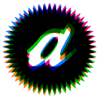

 Home
Home
